|
|
| |
|
 | Search: |
|
|
|
|
|
 |
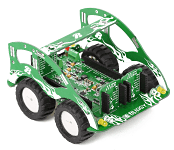
|
|
With the Buggy, you’ll be able to develop autonomus or semiautonomus robotic four-wheelers. Just plug in a clicker 2 or mikroMedia board into the driver’s seat (that’s the onboard clicker 2 / mikroMedia socket). Then tune it up, modify and repurpose it for any task — Buggy features three mikroBUS sockets; if you put a clicker 2 in the drivers’s seat, that’s five slots for various sensors and communication boards.
|
|
|
|
|
Microcontroller Boards > Display Boards > MikroMedia (2.8")
 |
MikroMedia boards feature a 2.8" touch-screen 320x240 TFT display, 3.5mm jack connected to a stereo MP3 codec and MicroSD card slot. They also feature a USB bootloader/programmer (depending on the board), meaning that no additional programmer is required.
Expansion shields are also available.
|

Accessory Boards
 |
Boards which can be used to add additional functionality to your design.
A very large variety are available, from accelerometers to GSM/GPRS modules.
Boards may feature an interface standard, such as IDC10 or mikroBus, which makes it easy to connect them to Development Systems or other boards which also feature that connection standard.
|
 |
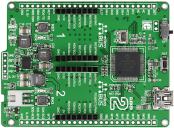
|
|
clicker 2 for PIC18FJ is a compact dev. kit with two mikroBUS sockets for click board connectivity. You can use it to quickly build your own gadgets with unique functionalities and features. It carries an 8-bit PIC18F87J50 device, preloaded with a fast USB-HID bootloader (no programmer necessary). The board also features a li-po battery connector and LTS3586-2 power management IC. Additional features include 2x26 connection pads on the sides of the board, and some buttons, switches and LEDs. |
|
|
|
 |
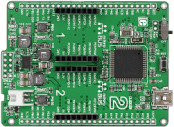
|
|
clicker 2 for STM32 is a compact dev. kit with two mikroBUS sockets for click board connectivity. You can use it to quickly build your own gadgets with unique functionalities and features. It carries STM32F407VGT6, a 32-bit ARM Cortex-M4 microcontroller, with a built-in USB-HID bootloader that makes it easy to program. A JTAG connector is also available. Whichever way you upload the firmware, you can turn clicker2 into a standalone gadget because it has a li-po battery connector. The battery (sold separately) can be charged via USB thanks to the LTC3586-2 power management IC that can also provide an independent power supply to the MCU's RTC. Additional features include 2x26 connection pads on the sides of the board, and some buttons, switches and LEDs. |
|
|
|
 |

|
|
clicker 2 for PIC32MX is a compact development kit with two mikroBUS sockets for click board connectivity. You can use it to quickly build your own gadgets with unique functionalities and features. It carries the PIC32MX460F512L MCU. |
|
|
|
 |
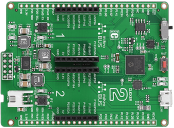
|
|
clicker 2 for CEC1302 is a compact development kit with two mikroBUS sockets for click board connectivity. You can use it to quickly build your own gadgets with unique functionalities and features. |
|
|
|
 |

|
|
clicker 2 is a battery-powered click board two-seater. NXP's K64 family of microcontrollers are optimized for low power applications, while preserving impressive performance across key specifications such as run power consumption down to 250 µA /MHz, Static power consumption down to 5.8 µA with full state retention and 5 µS wakeup. |
|
|
|
 |
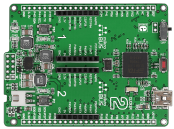
|
|
clicker 2 is a battery-powered click board with two mikroBUS sockets on board allowing you to take advantage of the huge potential of click boards. This clicker 2 is powered by FT900, a 32-bit FT32 core MCU that operates at 100MHz, has 256kB of flash, 64kB on-chip data memory, and 256kB shadow program memory. The shadow program memory is where the code is executed from, enabling the MCU to work with zero wait states at 100MHz — making it faster than many MCUs with higher clock rates. The onboard LTC 3586-1 IC will provide 3.3V or 5V to the clicks. It turns the USB port into a battery charger. For convenience, clicker 2 for FT900 features a reset button and an ON/OFF switch (you can also connect an external ON/OFF switch). clicker 2 has the same pocket-size form factor and the same pair of 1x26 connection pads as mikromedia boards. This makes it compatible with mikromedia shields letting you expand your device any way you want. |
|
|
|
 |

|
|
clicker 2 for PIC18FK is a compact PIC18 development kit with two mikroBUS™ sockets for click board connectivity. It carries an 8-bit PIC18F67K40 microcontroller from Microchip, with a built-in USB-HID bootloader that makes it easy to program. |
|
|
|
 |
|
|

